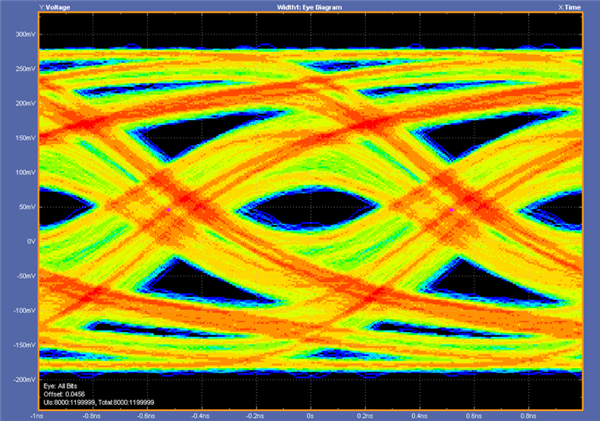Other Parts Discussed in Thread: DS25BR110, DS64BR111, SN75LVCP600, SN75LVCP600S
Hello,
I was wondering if anyone could help me evaluate the feasibility of using DS10BR150 for our application. We need a low power redriver to amplify 960Mbps CML signals from imaging sensor, and feed it to FPGA GTP transceiver. Both input and output of this redriver have to be AC coupled, in order to facilitate interfacing with stages before and after. The GTP seems to be compliant to LVDS, with AC coupling. Also the CML signals has gone through significant loss over long cable. As a result, eye diagram at the input of such redriver is weak and looks like below.
I have a few questions regarding DS10BR150. I would appreciate if we could get some confirmation as soon as possible, as this is a little urgent.
1. DS10BR150 is rated for 1Gbps. If we use it for 960Mbps, are you confident it is going to work with this rate? I know it sounds silly but in general people don't want to push for the limit, in order to have some margin. But in our case, its low power is really appealing to us. If this one will not work, could you recommend another solution? Low power is our biggest concern.
2. The eye from above is almost closed. Is DS10BR150 able to recover such eye? I don't find from the datasheet if it has an internal equalizer, so I am not sure. In addition, we don't need a fully open eye. According to specs of GTP transceiver, the minimum input amplitude (Vp-p) is 150mV. So as long as the eye height is larger than 150mV, we should be good. Higher is better.
3. Could you confirm if DS10BR150 needs external input bias voltage, if its input is AC coupled. The datasheet says it "allows simple AC or DC coupling" but all of pictures are for DC coupling. In addition, it doesn't mention the need of external bias voltage for both its input and output. It would be nice if this part has internal bias so we don't need to worry about that.
Thank you very much for your time. Any help would be greatly appreciated!
Dawei



